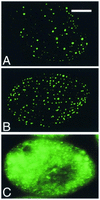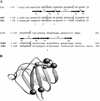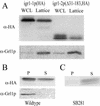New class of cargo protein in Tetrahymena thermophila dense core secretory granules
- PMID: 12456006
- PMCID: PMC117993
- DOI: 10.1128/EC.1.4.583-593.2002
New class of cargo protein in Tetrahymena thermophila dense core secretory granules
Abstract
Regulated exocytosis of dense core secretory granules releases biologically active proteins in a stimulus-dependent fashion. The packaging of the cargo within newly forming granules involves a transition: soluble polypeptides condense to form water-insoluble aggregates that constitute the granule cores. Following exocytosis, the cores generally disassemble to diffuse in the cell environment. The ciliates Tetrahymena thermophila and Paramecium tetraurelia have been advanced as genetically manipulatable systems for studying exocytosis via dense core granules. However, all of the known granule proteins in these organisms condense to form the architectural units of lattices that are insoluble both before and after exocytosis. Using an approach designed to detect new granule proteins, we have now identified Igr1p (induced during granule regeneration). By structural criteria, it is unrelated to the previously characterized lattice-forming proteins. It is distinct in that it is capable of dissociating from the insoluble lattice following secretion and therefore represents the first diffusible protein identified in ciliate granules.
Figures







Similar articles
-
Core formation and the acquisition of fusion competence are linked during secretory granule maturation in Tetrahymena.Traffic. 2005 Apr;6(4):303-23. doi: 10.1111/j.1600-0854.2005.00273.x. Traffic. 2005. PMID: 15752136 Free PMC article.
-
Out with a bang! Tetrahymena as a model system to study secretory granule biogenesis.Traffic. 2004 Feb;5(2):63-8. doi: 10.1046/j.1600-0854.2003.00155.x. Traffic. 2004. PMID: 14690495 Review.
-
Granule lattice protein 1 (Grl1p), an acidic, calcium-binding protein in Tetrahymena thermophila dense-core secretory granules, influences granule size, shape, content organization, and release but not protein sorting or condensation.J Cell Biol. 1996 Dec;135(6 Pt 2):1775-87. doi: 10.1083/jcb.135.6.1775. J Cell Biol. 1996. PMID: 8991090 Free PMC article.
-
Independent transport and sorting of functionally distinct protein families in Tetrahymena thermophila dense core secretory granules.Eukaryot Cell. 2009 Oct;8(10):1575-83. doi: 10.1128/EC.00151-09. Epub 2009 Aug 14. Eukaryot Cell. 2009. PMID: 19684282 Free PMC article.
-
An evolutionary balance: conservation vs innovation in ciliate membrane trafficking.Traffic. 2017 Jan;18(1):18-28. doi: 10.1111/tra.12450. Epub 2016 Oct 27. Traffic. 2017. PMID: 27696651 Free PMC article. Review.
Cited by
-
Lysosomal sorting receptors are essential for secretory granule biogenesis in Tetrahymena.J Cell Biol. 2013 Nov 11;203(3):537-50. doi: 10.1083/jcb.201305086. Epub 2013 Nov 4. J Cell Biol. 2013. PMID: 24189272 Free PMC article.
-
The Tetrahymena bcd1 mutant implicates endosome trafficking in ciliate, cortical pattern formation.Mol Biol Cell. 2023 Jul 1;34(8):ar82. doi: 10.1091/mbc.E22-11-0501. Epub 2023 May 10. Mol Biol Cell. 2023. PMID: 37163326 Free PMC article.
-
Diversification of CORVET tethers facilitates transport complexity in Tetrahymena thermophila.J Cell Sci. 2020 Feb 12;133(3):jcs238659. doi: 10.1242/jcs.238659. J Cell Sci. 2020. PMID: 31964712 Free PMC article.
-
Conservation and innovation in Tetrahymena membrane traffic: proteins, lipids, and compartments.Methods Cell Biol. 2012;109:141-75. doi: 10.1016/B978-0-12-385967-9.00006-2. Methods Cell Biol. 2012. PMID: 22444145 Free PMC article. Review.
-
Core formation and the acquisition of fusion competence are linked during secretory granule maturation in Tetrahymena.Traffic. 2005 Apr;6(4):303-23. doi: 10.1111/j.1600-0854.2005.00273.x. Traffic. 2005. PMID: 15752136 Free PMC article.
References
-
- Chan, C. W., Y. Saimi, and C. Kung. 1999. A new multigene family encoding calcium-dependent calmodulin-binding membrane proteins of Paramecium tetraurelia. Gene 231:21-32. - PubMed
Publication types
MeSH terms
Substances
Grants and funding
LinkOut - more resources
Full Text Sources
Other Literature Sources

